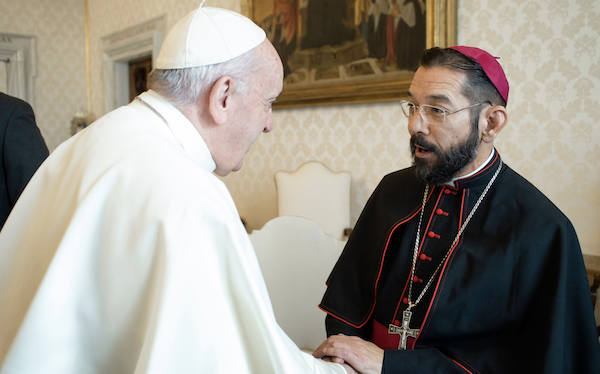
PROSPECT HEIGHTS — About seven months ahead of the first session of the General Assembly of the Synod of Bishops in Rome, the Vatican has announced a small planning committee for the gathering that includes Bishop Daniel Flores of Brownsville, Texas.
Bishop Flores, 61, has led the U.S. Catholic Church through the synod for the better part of the past two years. He is the lone U.S. bishop on the planning committee, which was established by the Secretary General of the Synod, Cardinal Mario Grech. As secretary general, Cardinal Grech will chair the committee.
Formally dubbed a “preparatory commission,” the committee was formed pursuant to Article 10 of the apostolic constitution “Episcopalis Communio,” which states that it’s established “for further exploration of the theme and for the redaction of any documents that may be issued prior to the Synod Assembly.”
Other members of the preparatory committee include:
- Father Giacomo Costa, who will serve as coordinator of the committee. Father Costa was previously the special secretary of the General Assembly of the Synod of Bishops for the Synod on Young People, Faith, and Vocational Discernment in 2018.
- Msgr. Tomasz Trafny, a Polish priest who is a member of the synod secretariat staff. Msgr. Trafny will serve as secretary of the committee.
- Archbishop Timothy Costelloe of Perth, who is president of the Australian bishops’ conference.
- Sister Shizue “Filo” Hirota from Tokyo, who is a consultant for the Japanese bishops’ conference Catholic Council for Justice and Peace. Sister Hirota is the only woman on the commission.
- Bishop Lucio Muandula of Xai-Xai, Mozambique, vice president of the Symposium of Episcopal Conferences of Africa and Madagascar.
- Father Dario Vitali, a professor of theology at the Pontifical Gregorian University in Rome.
As for Bishop Flores, in addition to his role as the head of the U.S. bishops’ synod process, he is the head of the USCCB Committee on Doctrine. He has led the Diocese of Brownsville — along the southern Texas-Mexico border — since 2010, as it has become one of the biggest and fastest-growing dioceses in the nation. It presently has a Catholic population of 1.2 million and is growing.
Pope Francis launched the synod on synodality in October 2021 with a theme of “For a Church that Journeys Together: Communion, Participation and Mission.” It began with a two-year timeline that was originally slated to conclude with the General Assembly of the Synod of Bishops in Rome this October.
Last October, however, the pontiff announced that the synod would continue for an extra year to allow for more time for discernment and a better understanding of synodality as a dimension of Church life.
As presently scheduled, Catholic bishops and other participants will gather in Rome for the first session of the Synod of Bishops from Oct. 4-29. That gathering will then be followed by a year of reflection, with another culminating meeting set for October 2024.
To date, the synod has already completed its diocesan and national phases, with Catholics worldwide providing feedback on the current state of the Church, including places it can improve and change. It’s currently in the final weeks of the continental phase.
Here in the U.S., a group of delegates representing 268 dioceses located in the United States and Canada recently gathered for a writing retreat to compose the response to the Vatican’s continental stage working document.
There were 17 delegates total on the trip. The response document will be submitted by March 31.
After the U.S. bishops published their national synod synthesis back in September, Bishop Flores called it a “significant moment” for the nation’s Church, while cautioning that it was the first step in a larger process.
“It is an invitation to listen, to discuss together and to discern together as the Church, about how best to understand and act upon those matters that sit deeply in the hearts and minds of the Catholics in the U.S.,” Bishop Flores said in an introductory statement to the 16-page document. “We have taken the first steps of this path, and we have learned much; we have more to learn and more to do.”
